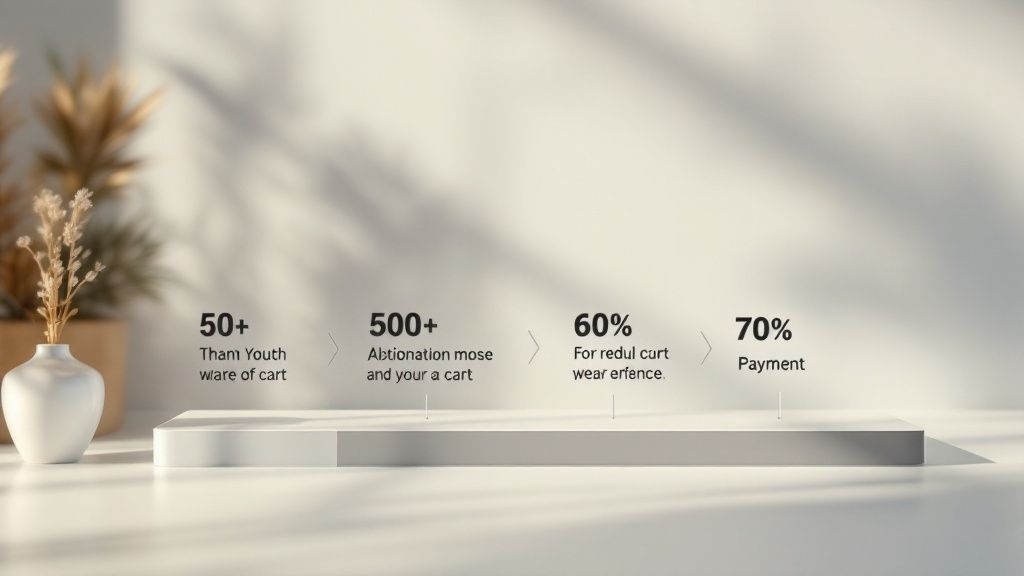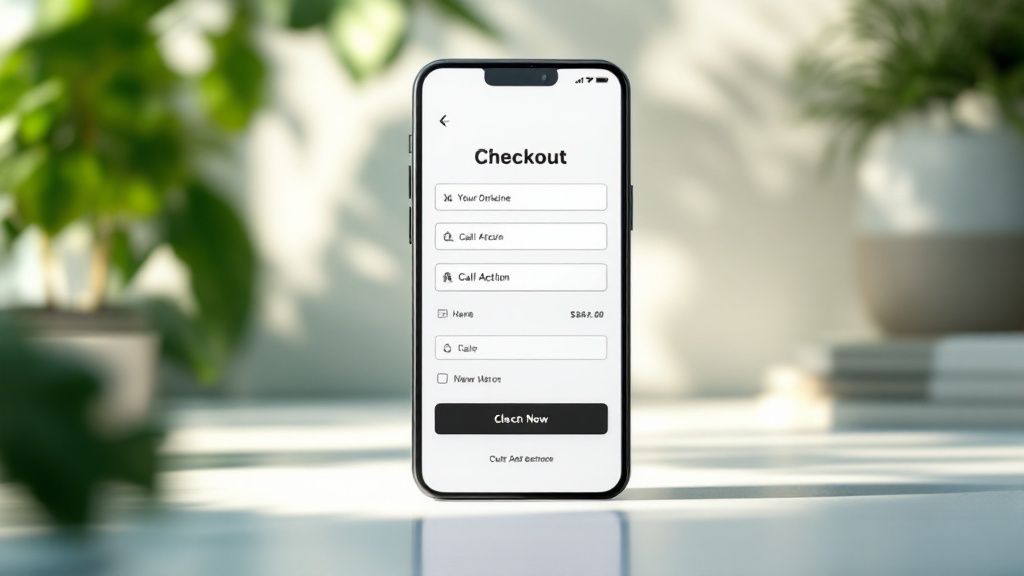Reduce Cart Abandonment: Proven Steps to Boost Sales
April 17, 2025

The Real Cost of Abandoned Carts: Statistics That Matter

Imagine a customer browsing your online store, adding items to their cart, and then simply leaving. This is the frustrating reality of cart abandonment, a problem that costs businesses billions. Understanding the scale of this issue is the first step to finding a solution.
The global average cart abandonment rate is a staggering 70.19% as of 2023. This means for every 10 shoppers, 7 leave without completing their purchase. This highlights the significant revenue loss businesses face. More detailed statistics can be found in the Baymard Institute research on cart abandonment rates.
Quantifying the Loss: What Abandoned Carts Really Mean
A 70% abandonment rate is alarming, but the true cost comes into focus when considering the potential revenue lost. The combined eCommerce markets of the US and EU totaled $738 billion in sales. A significant portion of these sales are lost due to avoidable issues like complicated checkout processes.
Improving the customer experience could unlock significant revenue. Optimizing checkout flows, for example, can improve conversion rates by up to 35.26%.
This means businesses could recover an estimated $260 billion annually by addressing these issues. This highlights the financial incentive to invest in strategies that reduce cart abandonment and maximize growth potential.
Beyond the Numbers: Understanding the Underlying Causes
Statistics alone don't tell the whole story. To truly combat cart abandonment, we need to understand why shoppers abandon their carts. Several key factors contribute to this issue.
To help illustrate these common reasons, let's take a look at the following table:
Common Reasons for Cart Abandonment
This table presents the top reasons shoppers abandon their carts based on consumer survey data.
| Abandonment Reason | Percentage of Shoppers |
|---|---|
| Unexpected Costs | 56% |
| Complex Checkout Process | 36% |
| Lack of Payment Options | 18% |
| Website Issues | 12% |
| Found a Better Price Elsewhere | 8% |
This data clearly shows that unexpected costs and a complex checkout process are the primary drivers of cart abandonment. This emphasizes the need for transparent pricing and a streamlined checkout experience. Let's explore these reasons in more detail:
-
Unexpected Costs: High shipping fees or unexpected costs revealed at checkout are major deterrents. Price transparency is crucial.
-
Complex Checkout Processes: Lengthy forms and confusing navigation frustrate shoppers. Streamlined and user-friendly checkout experiences are essential.
-
Lack of Payment Options: Not offering preferred payment methods like PayPal or Apple Pay can cause shoppers to abandon their purchase. Offering diverse payment gateways is vital.
-
Website Issues: Slow loading times, security concerns, and poor mobile optimization negatively impact the user experience. A seamless and optimized website across all devices is key.
By understanding these underlying causes, businesses can create targeted strategies to improve the customer journey and increase sales. Combined with the significant statistics surrounding cart abandonment, the case for strategic intervention is clear.
Device & Industry Patterns: Where Your Customers Disappear

Not all cart abandonment is created equal. To develop truly effective strategies for reducing it, understanding the where, why, and how is crucial. This means going beyond simple averages and digging into the specifics of your customer behavior. A targeted approach is vital for maximizing your impact.
The Mobile Gap: Why Smartphones Lead in Abandonment
Mobile commerce is experiencing rapid growth, but unfortunately, so is mobile cart abandonment. Mobile devices consistently have higher abandonment rates than desktops. This is often attributed to factors specific to the mobile shopping experience.
Smaller screens, slower loading times, and complicated checkout processes can create friction for shoppers. Addressing these mobile-specific challenges is essential for improving conversions. Optimizing your site for mobile users can make a significant difference in their shopping experience.
Industry Insights: Tailoring Strategies for Success
Abandonment rates also vary significantly across industries. For example, industries with higher price points, like travel and fashion, often see higher abandonment rates. This is due to longer decision-making cycles.
This requires a different approach compared to industries with lower price points, such as groceries. Tailoring your strategies to the unique challenges of your industry is vital. Consider how customer journey expectations vary by sector.
A customer booking a flight has different needs than someone buying a t-shirt. Addressing these differing expectations is key to reducing cart abandonment across the board. To understand these nuances, looking at industry benchmarks is helpful.
Let's explore some industry data to highlight these differences. The table below presents a comparison of cart abandonment rates across various devices and industry sectors.
Cart Abandonment Rates by Device and Industry
| Category | Mobile Rate | Desktop Rate | Industry Average |
|---|---|---|---|
| Fashion | 89.57% | 73.98% | 81.78% |
| Travel | 86.38% | 71.79% | 79.09% |
| Retail | 80.74% | 68.41% | 74.58% |
| Finance | 75.27% | 64.50% | 70.39% |
| Groceries | 70.71% | 60.39% | 65.55% |
As this data illustrates, mobile cart abandonment rates are consistently higher than desktop rates across all sectors. Fashion and travel experience notably high abandonment, while groceries maintain the lowest. This reinforces the importance of tailoring strategies based on both industry and device.
Cart abandonment can significantly impact eCommerce strategy. Mobile abandonment rates can reach 85.65%, while desktop hovers around 70-73%. Resources like Dynamic Yield offer valuable insights into these trends. This knowledge helps you allocate resources effectively.
Identifying Vulnerable Customer Segments: Prioritizing for Maximum Impact
Understanding where abandonment occurs is only half the battle. You also need to know who is abandoning their carts. Identifying vulnerable customer segments allows you to prioritize improvements for the greatest return.
For instance, social media traffic often has high abandonment rates (91%). This is because users are typically in the early stages of browsing. This highlights the importance of tailored social media campaigns.
Analyzing your data to pinpoint these segments and their pain points is essential. Creating effective, targeted strategies is key to reducing cart abandonment. Focusing on these high-impact areas maximizes your optimization efforts and boosts your bottom line.
Frictionless Checkout: The Path to Completion

The checkout process is the final hurdle for online shoppers. It’s where a potential sale converts into revenue or adds to your abandoned cart statistics. Optimizing this crucial stage is vital for reducing cart abandonment and boosting sales. A seamless checkout experience can significantly impact your bottom line.
One-Click Wonders: Simplifying the Purchase Process
Many leading eCommerce brands are adopting one-click purchasing. This streamlined approach minimizes the steps needed to complete a purchase, making it incredibly convenient for customers. It removes unnecessary friction, encouraging impulse buys and reducing the likelihood of abandonment due to a complex process.
Intelligent Forms: Gathering Essential Information Efficiently
Collecting customer information is necessary, but lengthy forms can deter shoppers. Intelligent form design is the solution. Minimize required fields, utilize auto-fill functionality, and optimize forms for mobile devices. This creates a faster and less cumbersome checkout process, improving the overall user experience.
Progress Indicators: Guiding Customers to the Finish Line
Progress indicators act as visual cues, guiding customers through the checkout process. They create a sense of momentum and reduce uncertainty. Just like signposts in a maze, progress indicators reassure shoppers they’re nearing completion, encouraging them to finalize the purchase. This clear visual feedback contributes to a more positive experience.
Check out our guide on 10 Shopify checkout customization tips to boost sales.
Mobile Optimization: Addressing the Unique Challenges of Small Screens
Mobile commerce is growing rapidly, and so is mobile cart abandonment. Optimizing the checkout for smaller screens is essential. Touch-friendly design and streamlined payment options are crucial for reducing friction on mobile. Consider the limitations of small screens and prioritize a simplified, intuitive mobile checkout flow.
Real-World Results: The Impact of Checkout Optimization
Checkout optimization has a significant impact on conversions. Companies implementing these strategies have seen substantial increases in conversion rates, demonstrating the tangible benefits of a frictionless checkout experience.
Identifying and Eliminating Friction Points: A Practical Framework
Reducing cart abandonment requires proactively identifying and eliminating friction points in your checkout process. Analyze customer behavior data, conduct user testing, and continuously refine your checkout flow based on feedback. This iterative process ensures your checkout remains optimized for maximum conversions. You might be interested in: How to reduce cart abandonment.
Transparent Pricing: Eliminating the #1 Abandonment Trigger

Unexpected costs are the leading cause of shopping cart abandonment. In fact, 56% of shoppers cite this as their primary reason for leaving. Many brands still reveal extra fees late in the checkout process, disrupting the customer journey and losing potential sales. Leading eCommerce companies, however, are moving towards transparent pricing throughout the entire shopping experience. This builds trust and fosters a positive customer relationship.
The Power of Upfront Pricing: Setting Clear Expectations
Imagine adding items to your online shopping cart, excited for your purchase, only to be surprised by unexpected shipping costs at the checkout. This is a guaranteed way to lose customers. Instead, present all costs early in the shopping journey. This upfront approach manages customer expectations and cultivates trust.
For example, clearly display shipping costs directly on product pages. Alternatively, offer a shipping cost calculator early in the browsing process. This transparency empowers customers to make well-informed purchasing decisions.
Strategic Shipping Thresholds: Increasing Average Order Value
Shipping costs can be a significant purchase deterrent. However, strategically implementing shipping thresholds can lessen this effect. Offering free shipping on orders above a certain value encourages customers to add more to their cart. This increases your average order value while simultaneously reducing cart abandonment.
Consider offering free shipping on orders over $50. This might encourage a customer to add an extra item just to reach that free shipping threshold.
Psychological Pricing: Addressing Price Sensitivity
Beyond simply displaying the price, consider the psychology behind it. Techniques such as charm pricing (ending prices in .99) or offering bundled deals can make prices appear more attractive. This works without significantly impacting your profit margins.
Clearly communicating the value proposition of your products can also justify higher prices and reduce price sensitivity. This is particularly important for premium brands.
Testing and Optimization: Finding What Works for Your Customers
There's no single perfect solution for presenting prices. A/B testing different strategies allows you to identify what works best for your specific audience. Experiment with different placements for pricing information, shipping threshold levels, and the wording of discounts.
This data-driven approach ensures your pricing strategy is optimized for maximum conversion. Checkout Links can help implement these strategies. By creating customized, shoppable links, they allow you to dynamically adjust pricing and promotions based on customer behavior. This further enhances your ability to reduce cart abandonment.
Building Trust Signals That Convert Hesitant Shoppers
In the world of eCommerce, trust is paramount. Hesitant shoppers need reassurance before making a purchase. This section explores how strategically placed trust signals can convert these hesitant shoppers into paying customers, directly impacting your efforts to reduce cart abandonment. These signals act as virtual handshakes, building confidence and encouraging conversions.
The Psychology of Trust: Why Security Matters
Consumers are increasingly aware of online security risks. Displaying visible signs of security is crucial for building trust and reducing cart abandonment. This could include SSL certificates, security badges, and clear privacy policies. For example, prominently displaying a well-recognized security badge can significantly increase conversions.
Think of it like choosing between two brick-and-mortar stores: one with a security guard and a well-lit entrance, the other dimly lit with no visible security. Most shoppers would instinctively feel safer in the first store. The same principle applies online.
Social Proof: Beyond Basic Reviews
While customer reviews are important, social proof extends beyond simple star ratings. Consider incorporating testimonials, user-generated content, and social media integrations to demonstrate the positive experiences of other shoppers. For instance, showcasing user-generated photos of your products on your social media channels can create a sense of community and authenticity.
This is similar to word-of-mouth marketing. People are more likely to trust recommendations from friends or other customers than traditional advertising. Leveraging social proof taps into this inherent human trust.
Trust Badges: Choosing the Right Symbols
Not all trust badges are created equal. Some carry more weight and recognition than others. Research which badges resonate most with your target audience and place them strategically throughout the checkout process. For example, a recognizable payment gateway logo, such as PayPal, can reassure shoppers about the security of their transactions.
These badges act like seals of approval, signifying that your business meets certain standards of quality and security. Choosing the right badges can have a significant impact on reassuring customers and reducing cart abandonment.
Targeted Trust Building: Addressing Specific Concerns
Different product categories and price points may require different trust-building strategies. For high-value items, consider offering money-back guarantees or extended warranties. Understanding your target audience's specific concerns is key to choosing the right trust signals. This targeted approach maximizes their effectiveness.
Checkout Links offer features to help implement these strategies. By creating personalized, shoppable links, businesses can dynamically apply discounts, present specific product bundles, and direct customers to customized landing pages addressing their particular needs, leading to increased conversions. This allows for a seamless and secure shopping experience that builds trust and reduces cart abandonment.
Recovery Campaigns That Bring Shoppers Back
Even with a frictionless checkout, some cart abandonment is unavoidable. But this doesn't mean those sales are lost. Well-executed recovery campaigns can re-engage shoppers and recapture lost revenue. The goal is to maximize recovery without encouraging intentional cart abandonment.
Timing Is Everything: The Golden Window for Reconnection
Timing is key for recovery efforts. Contacting a shopper too soon feels intrusive, while waiting too long risks losing their interest. Research suggests sending the first recovery email within one hour of cart abandonment, while the purchase is still top-of-mind.
Messaging That Matters: More Than Just a Reminder
Recovery messages should be more than just reminders. They’re opportunities to re-engage and address concerns. Highlight product benefits, reinforce trust, and offer incentives to encourage completion.
Consider reiterating free shipping, highlighting positive reviews, or offering a small, time-limited discount. Personalizing messages based on abandoned items boosts effectiveness.
Incentives That Convert: Finding the Sweet Spot
Incentives are powerful motivators, but balance is crucial. Overly generous discounts erode profits and can train customers to abandon carts expecting a deal. Start small and increase incentives gradually if needed. Free shipping, percentage discounts, or gifts with purchase are good options.
Multi-Channel Mastery: Sequencing for Success
Successful brands use a multi-channel approach, sequencing emails, SMS messages, and even browser notifications. This creates multiple touchpoints without being overwhelming. A first email reminder could be followed by an SMS message with a small discount, then a final email offering free shipping.
Personalization Is Key: Tailoring Your Approach
Personalizing recovery based on behavior, product categories, and abandonment triggers significantly improves results. A customer abandoning a high-value item might receive a personalized email with a consultation offer, while someone abandoning a lower-value item might receive a reminder with a free shipping incentive.
Examples of Effective Recovery Strategies: Real-World Success
-
Personalized email with abandoned items and a 10% discount: This targets specific items and provides a compelling incentive.
-
SMS message reminding about the cart and offering free shipping: This quick reminder removes a potential cost barrier.
-
Browser notification offering live chat with customer support: This proactive approach addresses concerns and provides real-time help.
Learn more in our article about How to reduce cart abandonment with proven strategies. Checkout Links helps you implement these strategies by creating customized, shoppable links that streamline the recovery process. These links pre-fill carts, apply discounts, and create a seamless path to purchase.
Measuring What Matters: Analytics That Drive Improvement
So far, we've explored strategies to reduce cart abandonment. But without the right data, these efforts are just guesswork. This section provides the analytical framework you need to refine your approach, turning abandoned carts into conversions and boosting revenue.
Identifying Key Metrics: Beyond Abandonment Rate
The cart abandonment rate is a good starting point, but it doesn't tell the whole story. Focusing on it alone can be misleading. Other essential metrics directly linked to revenue growth include:
- Cart Recovery Rate: This measures how effective your recovery campaigns are. How many abandoned carts are recovered through emails, SMS, or other methods?
- Checkout Completion Rate: This identifies friction in the checkout process. What percentage of shoppers who enter checkout complete their purchase?
- Average Order Value (AOV): A higher AOV can offset the impact of some abandonment. Are your strategies also encouraging larger purchases?
Avoiding Measurement Pitfalls: Common Mistakes to Avoid
For accurate measurement, avoid these common mistakes:
- Ignoring Customer Segments: Analyzing abandonment rates across segments (new vs. returning, mobile vs. desktop) provides valuable insights.
- Not Tracking Exit Points: Knowing where customers abandon (product page, cart, checkout steps) pinpoints friction.
- Overlooking External Factors: Sales, seasonality, and competitor activity can all affect abandonment rates. Context is key.
Implementing Effective Tracking: A Practical Guide
Setting up proper tracking involves these key steps:
- Integrate Analytics Tools: Make sure your platform integrates with tools like Google Analytics.
- Set Up Conversion Funnels: Define your customer journey steps to track drop-off points.
- Use Event Tracking: Track specific actions (add to cart, initiate checkout, complete purchase) for granular data.
A/B Testing for Continuous Improvement: Data-Driven Optimization
Leading eCommerce brands use A/B testing to refine their strategies. For instance:
- Test different checkout layouts for optimal design.
- Experiment with incentive amounts in recovery emails.
- Compare the impact of various trust badges on conversions.
Prioritizing Opportunities: A Framework for Maximum Impact
Not all optimizations are created equal. Prioritize based on:
- Potential Revenue Impact: Tackle the biggest revenue losses first.
- Implementation Complexity: Focus on quick wins, along with more complex projects with higher potential returns.
This data-driven approach empowers informed decisions, maximizing your efforts to reduce cart abandonment and drive revenue. Streamline your recovery process with tools like Checkout Links for Shopify, which creates customized, shoppable links.
 Checkout Links
Checkout Links



